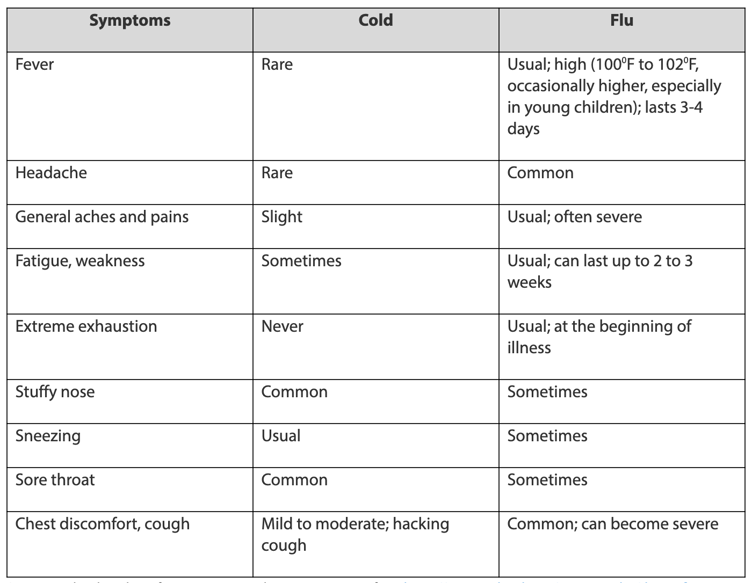Content adapted from Megan J. DiGiorgio, MSN, RN, CIC, FAPIC, Clinical Specialist at GOJO Industries.1
During the winter months, it seems that we all know someone who is sick. And although it is flu season, common cold viruses are also widely circulating right now. In fact, the average adult gets two to four colds per year, mostly between September and late April.2 Because these two types of viral respiratory illnesses have similar symptoms, it can be hard to distinguish between them based on symptoms alone.
In general, the flu is more severe than the common cold. Colds typically do not result in serious complications, such as pneumonia, bacterial infections, or hospitalizations. In some cases, diagnostic testing may need to be done to determine whether a person has a cold or the flu.
So how can you tell if it is the cold or flu? Here are some general differences:
 Source: WebMd Media References. Retrieved January 14, 2019, from https://www.webmd.com/a-to-z-guides/discomfort-15/cold-flu-season/is-it-a-cold-or-flu
Source: WebMd Media References. Retrieved January 14, 2019, from https://www.webmd.com/a-to-z-guides/discomfort-15/cold-flu-season/is-it-a-cold-or-fluRegardless of whether the culprit is the cold or the flu, there are some general infection prevention and control principles that every person should follow to stay healthy during cold and flu season.
1. Get your flu vaccine. This is the most important measure you can take. Remember, you can’t get the flu from the flu vaccine because it’s either made with inactivated virus, no virus at all, or a weakened virus that cannot cause illness. Although the CDC recommends that you should get a flu vaccine before flu begins spreading in your community (by the end of October), getting vaccinated throughout the flu season, even into January or later, can still be beneficial.3
2. Practice good hand hygiene. Wash your hands with soap and water or use an alcohol-based hand sanitizer with at least 60% alcohol.
3. Disinfect and clean surfaces often. Frequent disinfection of surfaces can drastically reduce the number of germs on surfaces that can infect you via indirect contact.
4. Avoid touching your eyes, nose, and mouth. Germs from your hands can enter your body through your eyes, nose and mouth.
5. Cover your cough or sneeze. Cough or sneeze into your sleeve or into a tissue and then perform hand hygiene immediately.
6. Stay home if you are sick, and limit contact with others as much as possible. A good rule of thumb is to stay home for at least 24 hours after your fever is gone (without the use of fever-reducing medications).
For more information about the flu and the most up-to-date information about this year’s flu season, visit the CDC’s flu web page.
Sources:
1. Gojo USA Blog. Know the Difference Between a Cold or the Flu by Megan J. DiGiorgio, MSN, RN, CIC, FAPIC. Retrieved January 7, 2020 from http://www.gojo.com/en/Newsroom/Blog/2019/Know-The-Difference-Between-A-Cold-Or-The-Flu?sc_lang=en
2. WedMD. Common Cold Overview. Retrieved January 14, 2019, from https://www.webmd.com/cold-and-flu/common_cold_overview
3. Centers for Disease Control and Prevention. Get Vaccinated. Retrieved January 14, 2019, from https://www.cdc.gov/flu/consumer/vaccinations.htm#when-vaccinate



